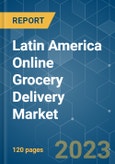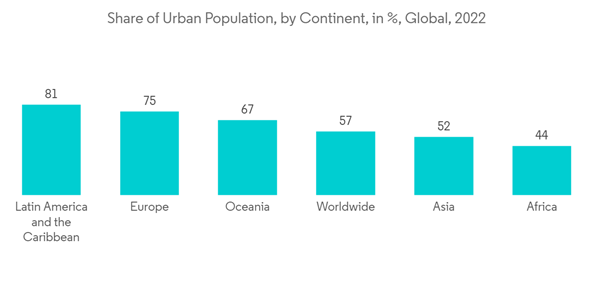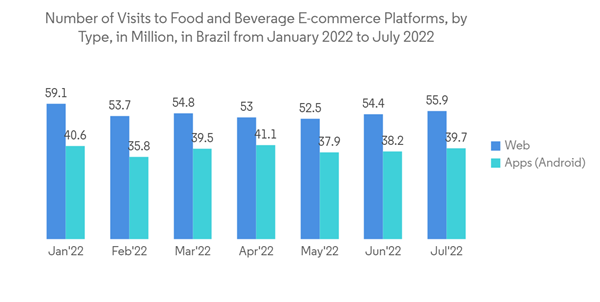Key Highlights
- Online grocery ordering has become increasingly popular in recent years. One of the primary drivers of market growth is the increasing proliferation of smartphones and internet connections, which allow for very easy and speedy meal delivery. According to GSMA Intelligence, the number of mobile customers in Latin America will reach over 450 million by the end of 2021, rising to 485 million by 2025.
- Demand fluctuations in online delivery are frequently unpredictable and severe. As a result, managing delivery executives and devising tactics to increase delivery profitability becomes tough. Savvy restaurants are embracing crowdsourcing technologies to accommodate flexible food delivery demands. Crowdsourcing enables food establishments to outsource deliveries to temporary and part-time delivery executives based on costs, productivity, client proximity, and other factors. Crowdsourcing is quickly gaining popularity as a smart strategy to ensure delivery scalability and reduce expenses.
- The popularity of virtual assistants is growing as new and innovative capabilities are added regularly. Like Twitter, Domino's quickly recognized an opportunity and capitalized on it by creating their pizza bot, Dom. This bot may take orders, notify clients about vouchers, and share their most recent bargains. For example, GrubHub, an online food ordering company, integrates with Alexa, Amazon's smart assistant. Customers can order from any of their previous three transactions. When a customer tells Alexa what they want to order, the action is performed, and the anticipated delivery time is announced.
- The COVID-19 outbreak particularly heavily struck the grocery service industry. Many Latin American countries went into lockdown to try to contain the spread. In this scenario, meal delivery became the only way for grocery service firms to stay open during the pandemic. However, stricter safety and hygiene regulations have compelled delivery companies to use contactless delivery. Operators in Brazil, for example, are looking into meal kits and ready meals to increase their services. To address the rising demand for pampering and convenience, supermarket chain Pao de Acucar's Cheftime Restaurant prepares meals in the supermarkets' idle kitchens and deli stations.
- As grocery delivery services grow in popularity, they face a regulatory issue. Currently, delivery personnel who use these new apps are not formally hired. Grocery tech firms' business models rely on independent delivery workers who pick when and how many deliveries to accept. This has created uncertainties about labor standards in most LATAM countries, with some enterprises even being suspended. Online grocery delivery companies must ensure that their work policies are legal while also contributing to the creation of new jobs and the growth of local economies.
Latin America Online Grocery Market Trends
Increase in Urbanization is Expected to Drive the Market
- According to the Population Reference Bureau, Latin America's urbanization rate has reached 81% in the last year. Furthermore, according to the World Bank, metropolitan areas and cities would house approximately 81 percent of Latin America's and the Caribbean's total population in 2021. The vast majority of people living in cities would allow the studied market to expand.
- According to the IMF, the region's economy grew by about 4% last year, there were a lot more jobs, and the service sector got back on its feet after the pandemic.Inflationary pressures are easing in many nations due to central banks' early and aggressive efforts and decreasing global food and energy costs. However, core inflation (excluding food and energy) remains high in Brazil, Mexico, and Chile, hovering around 8%. With this kind of slow growth in jobs, people are likely to spend more, which would drive the market.
- Rural urbanization has increased in recent years. Agriculture, traditional local services, and small-scale manufacturing are being phased out in favor of modern industry. According to urban ecology research, larger cities provide more specialized goods and services to the local market and surrounding areas, serve as transportation and wholesale hubs for smaller places, accumulate more capital, provide financial service provision and an educated labor force, and frequently concentrate administrative functions for the area in which they are located.
- Commerce and trade are essential factors in urbanization. The contemporary era's distribution of goods and services and commercial transactions have resulted in the development of modern marketing organizations and exchange methods, which have greatly accelerated the construction of towns and cities. Commercialization and commerce are associated with the prevalent notion that towns and cities provide better commercial opportunities and returns than rural places.
- There are various social advantages to living in cities and towns. There are examples of better educational facilities, higher living standards, improved sanitation and housing, improved health care, improved recreation facilities, and improved social life. As a result, more individuals are being compelled to migrate to cities and towns to access a wide range of social benefits and services unavailable in rural areas.
Brazil is Expected to Hold Major share
- According to Google Trends, Brazil's food and beverage e-commerce platforms receive over 90 million visits per month. In July last year, food and drink shopping websites received 95.6 million visitors, with Android applications accounting for more than half (55.9 million). November and December saw the most robust online demand for online food businesses.
- Furthermore, many restaurants provide discounts to customers who order groceries through mobile applications. The increasing number of restaurants attempting to enhance foot traffic by developing their online presence through websites can be related to the expansion of the desktop sector. The development of the e-commerce industry promotes the adoption of websites and desktop channels for online meal ordering. Furthermore, incorporating AI and VR into desktops and laptops will drive the segment's growth.
- While third-party delivery alternatives are expanding, so is the number of restaurants and grocery shops abandoning third-party food delivery service providers in favor of developing their own in-house grocery delivery management platforms. The primary motivation for doing so is to reclaim control over grocery distribution. Grocers recognize that delivery is an essential element of the consumer experience. A poor delivery - even if caused by a third-party source - will always be put on the grocer. As a result, bringing operations in-house makes sense to assure consistency and quality throughout the client journey.
- Online grocery retailers today recognize the necessity of using customer data to enhance efficiency, save costs, and, most significantly, improve the customer experience as digitization enables assessing delivery success and its correlation to increased profits. With third parties handling such a significant portion of the delivery flow, it's no surprise that grocery providers are turning to data collection and analysis to understand their delivery operations better. Using data could give players in the Brazil area a chance to get a bigger share of the market.
The rise in investments in cloud kitchens and dark kitchens is expected to drive the study market. For example, in Latin America, investors are looking for dark kitchens. Mimic, a Brazilian business, can attest to this after receiving USD 9 million in a seed round. Monashees led the investment, with Canary and Valor Capital Group also contributing. Individual investors with extensive experience running their own enterprises in Brazil also joined them.
Latin America Online Grocery Market Competitor Analysis
The Latin American online grocery delivery market is moderately competitive owing to the presence of multiple players. The players in the market are adopting strategies like product innovation, mergers, and acquisitions in order to expand their product portfolios, expand their geographic reach, and primarily to stay competitive in the market.In July 2022, Future Farm, a Brazilian plant-based food tech startup, will launch a series of restaurant takeovers in Los Angeles to put more plant-based meat on menus. The brand works with the Italian deli Ggiata, the pizza place Prince Street Pizza, the coffee shop Cofax, which has a baseball theme, and the burger takeout place Golden State to make plant-based food.
In March 2022, Wendy's, a fast-food restaurant chain, will expand its operations in Mexico. Wendy's anticipates having 'hundreds' of stores in Mexico. In addition to the chain's basic menu, which includes burgers and Frosty desserts, the business is designing a distinct national menu for the country, featuring limited-time deals suited to the Mexican market.
Additional benefits of purchasing the report:
- The market estimate (ME) sheet in Excel format
- 3 months of analyst support
This product will be delivered within 2 business days.
Table of Contents
Companies Mentioned (Partial List)
A selection of companies mentioned in this report includes, but is not limited to:
- Walmart Grocery
- Uber Eats
- Cornershop
- Mercadoni
- Glovo
- Instacart
- Amigo
- Mercado Fresh
- Amazon Grocery










